Contents
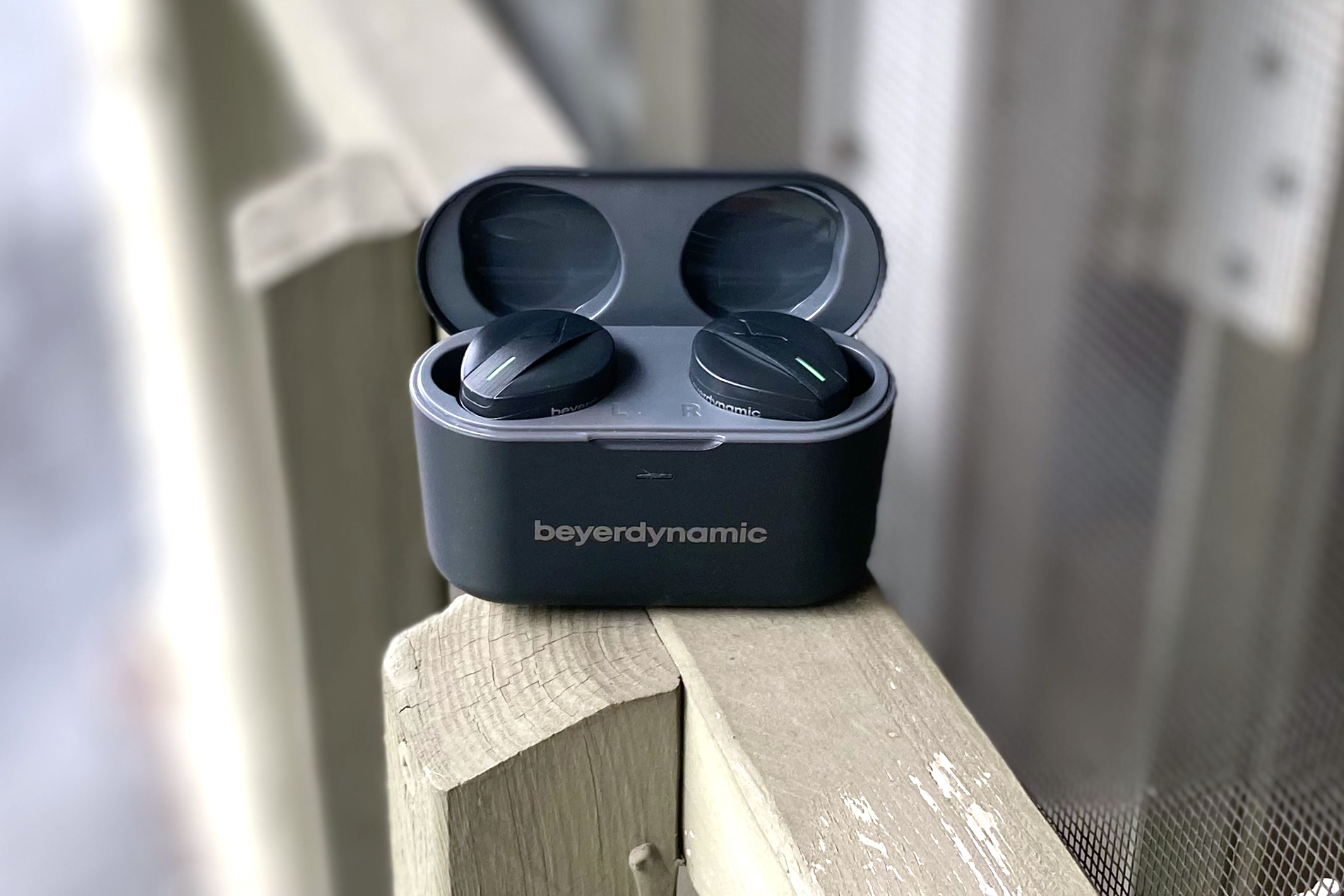
BeyerDynamic Free BYRD TWS headphones
MSRP $249.00
“Silky sound and huge stamina make for a good set of Apple alternatives.”
Pros
- Great sound quality
- Good ANC and transparency
- Wireless charging
- Excellent battery life
- Very good controls
- Wear sensors
- IPX4 water resistance
Cons
- No Bluetooth multipoint
- Needs app for best sound quality
- Mediocre call quality
- Possible fit issues
- Limited customization
Never heard of Beyerdynamic? You’re not alone. That’s because the nearly 100-year-old company has focused on the needs of audio professionals and audiophiles for most of its existence. In fact, with the exception of its growing lineup of gaming headsets, it makes just a handful of products aimed squarely at day-to-day music listening.
But with the launch of its first set of true wireless earbuds, the aptly named $249 Free Byrd, Beyerdynamic has joined the ranks of Sony, Bose, Apple, Sennheiser, and Jabra with an audio product anyone can enjoy.
The Free Byrd bring with them Beyerdynamic’s impressive reputation for high-quality audio, huge battery life, and sound personalization software. Is that enough for these byrds to fly above the crowd? Let’s check ’em out.
What’s in the box?
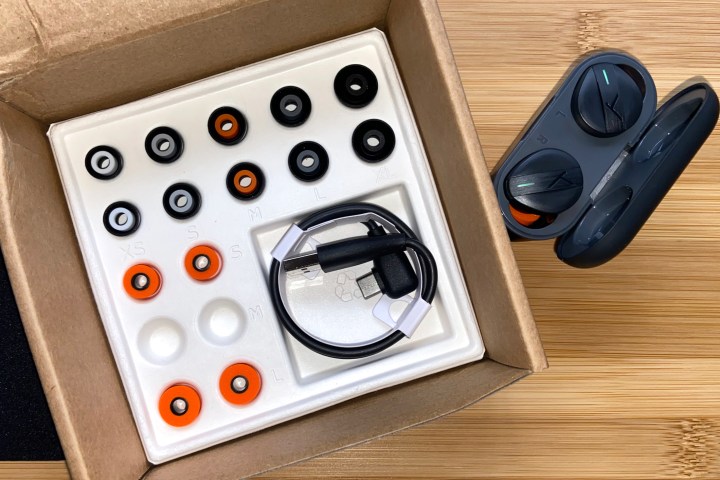
Inside the fully recyclable, plain cardboard box, you’ll find the Free Byrd earbuds, their charging case, a USB-C charging cable, a set of printed instructions, and a very generous set of eartips — five sizes of silicone tips and three sizes of memory foam tips.
The earbuds come from the factory without any of these tips installed, encouraging you to try different sizes and types before you settle on your favorites. To get the most out of the Free Byrd, you’ll need the free Beyerdynamic MIY (Make It Yours) app for iOS or Android.
Design
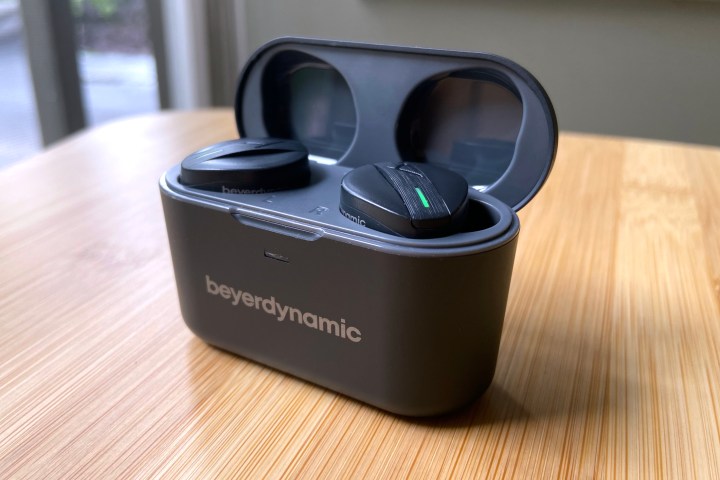
Available in white or black, the Free Byrd are fairly chunky. They’re smaller than the Sony WF-1000XM4, but larger than the Sennheiser Momentum True Wireless 3. A black, brushed-metal band with a discrete, embossed Beyerdynamic “Y” logo cuts across the teardrop shape of the buds’ outer surface. The logo also acts as the touch control. Each earbud has a large LED indicator to tell you how much battery charge is left, or help you determine if the buds are in pairing mode.
Though they will protrude from your ears a bit, it’s still a slick, sophisticated design that manages to differentiate itself amid a sea of wireless earbuds.
The size actually is beneficial when it comes to getting a good grip on the buds, both for removing them from their charging case (which is easy), as well as being able to twist them securely into place in your ear.
Comfort became an issue, especially after an hour or so of continuous wear.
The Free Byrd are rated IPX4 for water protection, which means a bit of sweat or rain is no cause for concern, but as we’ll see in a moment, they might not be well-suited to workouts.
The case itself is just small enough to be pocketable — though still massive when compared to that of the AirPods Pro — and the lid and hinge are very well-built, snapping open and closed with ease. You can charge it up with the included USB-A to USB-C charging cable, or you can charge it wirelessly with any Qi-compatible charging mat. A clearly visible LED on the front shows you the case’s charging status and its battery level when not plugged in.
Comfort, controls, and connections
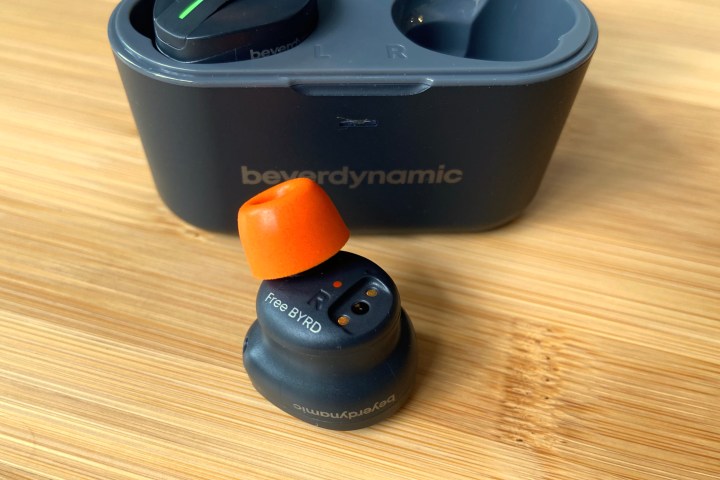
It’s worth taking note of how the interior portion of the Free Byrd is shaped. Though smaller than the outer shell, and very smooth and rounded, it’s got a relatively large surface area. The sound tube (the part the eartip is attached to) is quite stubby, and this combination could prove problematic for both those with small ears and those whose ear canals sit a little deeper.
With the standard silicone tips installed, I simply couldn’t get the Free Byrd to grip the entrance of my ear canal. It’s not the tips — they’re very well made — it’s that the large interior surface I mentioned prevented me from being able to push them in far enough.
The touch controls are excellent. Thanks to the raised metal band, you know exactly where to tap.
Thankfully, the medium foam eartips proved much better at giving me the seal I needed. Beyerdynamic says it included the foam tips “for use during sporting activities,” but for me, they were a requirement no matter what I was doing.
But even with the foam tips, I found I wanted to regularly give them a bit of a double twist and push to keep them secure. They proved fine for walking and low-impact cardio like stair climbing and elliptical machines, but I can’t recommend them for any kind of higher-impact activities. I also found that comfort became an issue, especially after an hour or so of continuous wear. Normally, I’d say these things are subjective (because they are) and your mileage may vary. But I find most earbuds quite comfortable, which tells me Beyerdynamic might have to revisit the shape for the next version of the Free Byrd.
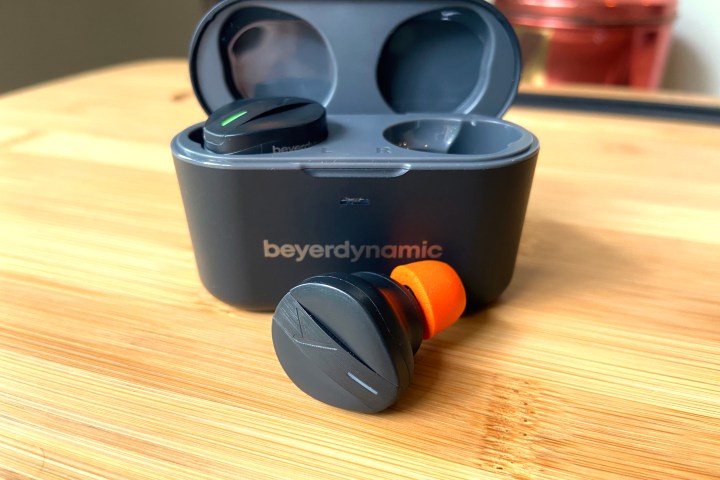
The touch controls are excellent. Thanks to the raised metal band, you know exactly where to tap, and each tap is accompanied by a short tone to let you know you’ve tapped correctly. It even provides much needed feedback for multi-tap gestures, with a low-medium tone combo for double-taps and a low-medium-high combo for triple-taps.
Your biggest challenge might be memorizing all of these gestures, because the Free Byrd let you do it all, including play/pause, switch active noise cancellation (ANC) modes, skip tracks, change volume, call answer/end/reject, and access your preferred voice assistant (Siri on iOS devices and Google Assistant or Alexa on Android). However, if you choose to use just a single earbud, you’re reduced to play/pause, call answer/end/reject, and voice assistant access.
The Free Byrd sound fantastic, with a better overall performance than the similarly priced AirPods Pro.
The only thing missing is the ability to customize these gestures within the MIY app. The earbuds are also equipped with wear sensors, which auto-pause and resume your tunes when you remove or reinsert them. I’m a big fan of wear sensors, but in this case, Beyerdynamic has reduced their value somewhat by not providing two key functions: The ability to turn them off, or to decide if you want them to auto-pause and resume or just pause.
Android users get an almost instant pairing experience via Google Fast Pair. It’s not much slower on iOS devices; pairing only requires the extra step of going into the Bluetooth devices list page. I found the connection was almost 100% reliable, with only two very minor, split-second dropouts over the entire weeklong period I used them. Wireless range is fairly standard for Bluetooth earbuds — about 20 to 25 feet indoors and up to 50 feet outside.
Unfortunately, there’s no Bluetooth multipoint for connecting two devices to the Free Byrds simultaneously, which is a bit of an inconvenience when you want to move between a phone and a PC (for example) several times during the day. However, there’s no need to disconnect manually when you want to switch — as long as the earbuds have been previously paired with a device, you can simply select them from that Bluetooth menu, and the buds will switch over painlessly.
Sound quality
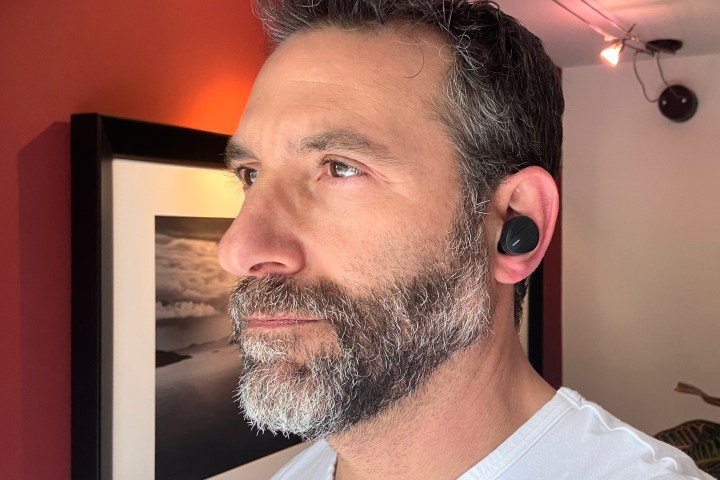
The Free Byrd sound fantastic, with a better overall performance than the similarly priced AirPods Pro and Sennheiser Momentum True Wireless 3, and with comparable performance to the Technics EAH-AZ60. But, in order to get the most out of these earbuds, you’ll need to use the Mimi sound personalization feature that’s built into the MIY app, and then fine-tune the sound using the app’s EQ presets.
Mimi is one of the few sound personalization systems that I’ve found to be consistently helpful in getting better sound. It’s effectively a hearing test. Each ear is fed a series of tones played against a white noise backdrop. For each tone, the volume level starts loud and then progressively drops off. You let the test know when you can no longer hear it distinctly. After about five minutes of this, the app figures out if there are any frequencies you struggle with and adjusts the earbuds’ EQ accordingly.
Once Mimi has done its thing, you can turn the resulting EQ modifications on or off with a simple toggle button in the app, so you can hear the difference it makes. Or, you can use a slider to decide how intense that modification should sound — from nothing to 100%. And if your results match mine, you’ll simply leave it cranked up — it’s like night and day.
Without the Mimi mod, the Free Byrd feel constrained and flat, lacking in both energy and dynamic range. Turn it on and these Byrds fly free, producing a wide, deep soundstage where the subtleties contained in each song can be heard and appreciated.
There’s plenty of bass, with a strong, resonant authority, as well as excellent detail in both the midranges and highs. If your phone supports aptX Adaptive or aptX HD, you’ll be treated to the possibilities of wireless, hi-res support (assuming your music source supports it), but even on the non-hi-res iPhone, it’s a rewarding listening experience.
Beyerdynamic doesn’t give you full rein over your EQ — there are no manual adjustments — but you do get a series of six EQ presets, including V-shape, which boosts bass and treble (perfect for workouts or action movies), and speech, which improves clarity for content like podcasts.
ANC and transparency

The Free Byrd possess decent active noise cancellation. It’s not the best you’ll find at this price — both the AirPods Pro and the $230 Technics EAH-AZ60 offer better coverage of frequencies for a more effective overall level of quiet — but it’s more than enough to take the edge off a busy office, coffee shop, or traffic sounds.
Transparency mode also works well, but with the same caveat: it can’t beat the exceptional AirPods Pro, but it’s perfectly adequate for having conversations or just generally being aware of your surroundings when that’s a safer/more desirable thing than blocking out sounds.
By default, a double-tap on the left earbud will switch you quickly between ANC and transparency modes, but if you want to shut them both off — perhaps to save on battery life — you’ll need to do that in the app.
Unfortunately, there’s no way to turn off the voice prompt that announces these mode changes. Your only option is to decide if you want to hear them in English or German.
Optional game mode
If you like to game, whether on a mobile device or a computer, Bluetooth connections can often introduce an unacceptable amount of delay between when an action takes place in the game and when you actually hear it. This tends to be especially true when using higher-quality codecs like AAC, because these codecs prioritize sound over immediacy.
Like an increasing number of wireless earbuds, the Free Byrd offer a gaming mode that attempts to reduce this lag time as much as possible. Beyerdynamic says it can shorten delays by as much as 100 milliseconds, which is considerable. But keep in mind, there’s only so much you can do to reduce Bluetooth latency, and even with game mode engaged, delays of between 32 millieseconds and 60 milliseconds are still to be expected.
Call quality
The Free Byrd have two mics per earbud, which helps them pick up your voice clearly for phone calls and videoconferencing, but you’ll need to find a quiet location. Wind noise is relatively well managed, but when competing sounds are introduced, like the din of a coffee shop or the abrupt volume changes associated with traffic, the earbuds struggle to keep those noises in check while keeping your voice audible.
If call quality is a top consideration, you may want to consider other models.
Battery life
Beyerdynamic claims you’ll get about eight hours per charge on the Free Byrd when ANC is active and volume is maxed out at 100%, but you can extend that a lot — as long as 11 hours if you listen at a more reasonable level and keep ANC turned off. Unfortunately, because there’s no way to defeat the earbuds’ wear sensors, and the buds power themselves down automatically when they aren’t being actively used, it was impossible to verify these claims in full.
But based on the MIY app’s reported battery levels after a few hours of use, they seem to be relatively accurate. That’s excellent performance for a set of wireless earbuds, and the charging case extends that life to a maximum of 30 hours, which is also very good.
The only thing that could do with some improvement is the fast-charge feature, which delivers a claimed 70 minutes after 10 minutes of charging. That’s on the slow side, with the AirPods Pro and Jabra Elite 7 Pro both delivering 60 minutes after five minutes of charging.
Our take
Beyerdynamic doesn’t get everything right on the Free Byrd — after all, these are its first set of true wireless earbuds. But with great sound quality, excellent battery life, good controls, and capable ANC, they’re a strong alternative to Apple’s AirPods Pro for those who want better sound and a set of earbuds that don’t need to be returned to their charging case after every online meeting.
Is there a better alternative?
The Free Byrd are good, but there’s strong competition at this price. The $249 AirPods Pro are more comfortable and have better noise canceling and transparency, but they can’t compete on sound quality or battery life. Both have wireless charging, but neither offer Bluetooth multipoint,
Meanwhile, the $229 Technics EAH-AZ60 deliver superb sound, ANC, hi-res audio, hands-free Alexa, Bluetooth multipoint, and an enormous number of app-based customizations. However, they lack wireless charging and wear sensors. And battery life at seven hours per charge and 25 hours total is good but nothing special.
How long will they last?
Always hard to say, especially for a new product with no track record, but since batteries are usually the one component in a set of wireless buds that determine how long they’ll last, I’d say the Free Byrd should end up being better than most, thanks to their large capacity.
Beyerdynamic backs them with a two-year warranty, which is one year longer than most manufacturers.
Should you buy them?
Yes. The Free Byrd are a great choice for audio enthusiasts looking for earbuds that outperform other choices at this price. Just be aware that, depending on your ears, the fit could be a challenge.
Editors’ Recommendations





